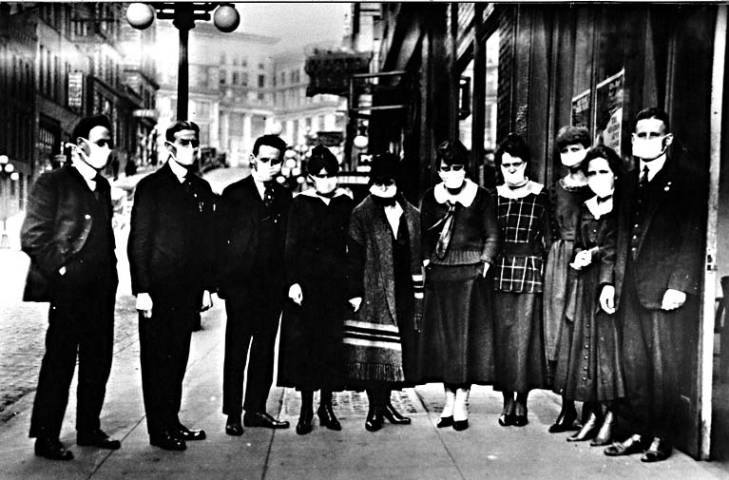
At the height of World War I, Spanish Influenza ravaged Hoosier servicemen and servicewomen. Fortunately, city and health officials acted quickly in the fall of 1918, resulting in Indianapolis having one of the lowest casualty rates in the country, according to IHB historian Jill Weiss Simins. But how were Hoosiers’ daily lives impacted by the dread malady? As we can now relate, the public was consumed with news reports about the pandemic and resultant quarantine, which we will re-examine here via Newspapers.com and the freely-accessible Hoosier State Chronicles.
The flu struck Fort Benjamin Harrison in September of 1918 and by October 6, U.S. public health service officials mandated a statewide quarantine for Indiana and most other states. [1] Making us grateful for the immediacy of Apple News and Google Alerts, state board officials at the time spread the news by dispatching telegrams to board secretaries in every county, ordering them to “immediately close all schools, churches, theaters, amusements of all kinds, and to put a ban on all public meetings and gatherings.” [2] The order initially exempted factories, “business houses,” and restaurants, and limited confectionaries’ services.
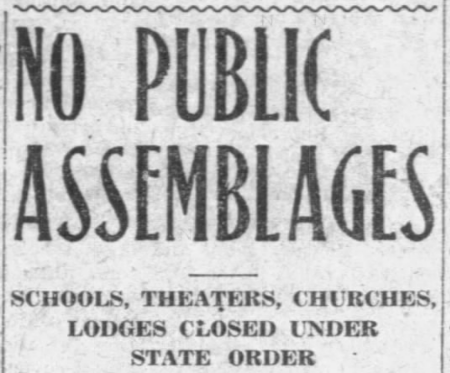
Much like now, some Hoosiers pushed back against the ban, deeming it unnecessary as influenza patients, in their estimation, suffered from nothing more than “heavy colds.” [3] A Terre Haute high schooler placed an ad in the paper the day after the public health announcement, stating “can work all day during quarantine.” [4] Perhaps in response to this disregard, health officials across the state placed “influenza placards” at the residences of those infected as a measure to keep the community safe. [5]
Quarantined individuals communicated through letters printed in local papers, detailing how they passed their time. Four Hammond soldiers quarantined at Camp Sherman, Ohio wrote, “I guess we Hoosiers are too strong bodied to have it for we are well at this time.” [6] A quarantine pastime familiar to us today, they reported doing “nothing much but eating and sleeping.” After a little drilling, they “played games and bullfrog. We have boxing contests and concerts of our own.” Of their new normal, they wrote, “We are our own washowmen [sic] for we are orphans without wives or mother, but one great Uncle who is Uncle Sam, but we have the time of our lives just the same.” [7] At night, the men caught up on local news by browsing Hammond papers by candlelight, likely searching for the names of friends and family who may have fallen victim to the malady.
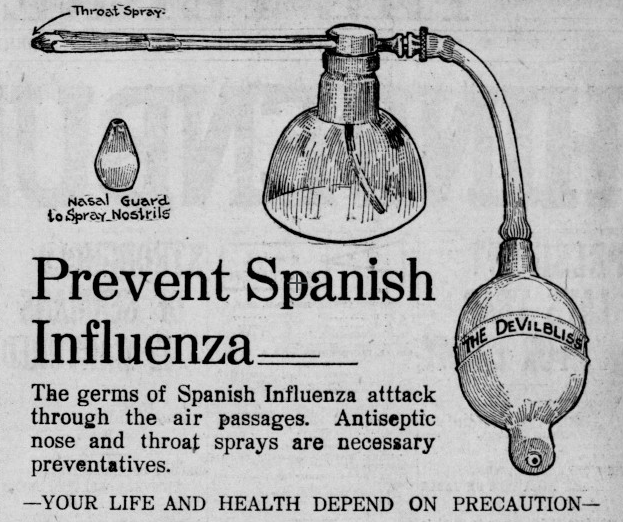
According to the Columbus, Indiana Republic, quarantine wasn’t just a matter of public health but patriotism during World War I. The paper urged readers to have “common sense,” as the epidemic ravaged healthy U.S. troops and argued that quarantine “is of vital importance in connection with the war and the sooner the disease is stamped out the better it will be for war conditions.” [8] Given the global conflict, one South Bend writer framed quarantine as a much needed pause contending, “In our present nervous state of society, due to the war, the Liberty loan, the draft, etc. . . we have found something new to nurse our nervousness; and possibly the quarantine is necessary as a means of rest.” [9]
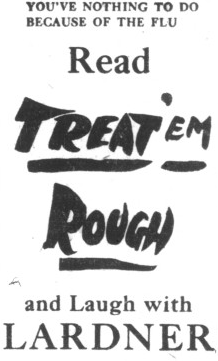
For many Hoosiers, the practical took precedent over the patriotic during the shutdown. Teachers in Seymour wanted to know if they would still be paid while classes were suspended. Fortunately, the state ruled that they would receive full wages because it would be wrong to lose money due to an “order over which they have no control.” [10] Unfortunately, they would not be able to spend these wages on libations, as Seymour health officials ordered “all near beer places of business to be closed” the next day. [11] Nor could they worship together, as pastors across the city appealed to congregants to conduct services from their own homes. [12]
As the “enforced vacation” dragged on, Richmond children felt as if they “were having summer vacation once more.” [13] One nostalgic girl wrote to the Palladium-Item with recollections of her summer visit to see family in Boston. With the sunny season a mere glimmer in one’s eye, the YMCA of Evansville distributed cards advising residents—who now lacked the “old excuse of ‘I haven’t time'”—to exercise for thirty minutes three times per week. [14] It’s no #situpchallenge, but Richmond’s Earlham College got creative with physical fitness during their four weeks as “strangers to world outside.” The school converted the chapel into a calesthentics area, and female faculty members played hockey and baseball. [15]
The quarantine also impacted politics, disrupting campaigns for the November congressional election. Unable to stump across the nation, candidates sought to sway local electors via “letters and heart to heart talks.” [16] They scattered campaign cards and held “street corner sessions,” where they informed citizens about political platforms from afar—social distancing, anyone? Voter turn-out was low, as expected, and experts predict the Coronavirus will have a similar effect on the 2020 congressional and presidential elections. In fact, as of this date, Indiana’s primaries have been pushed back to June.
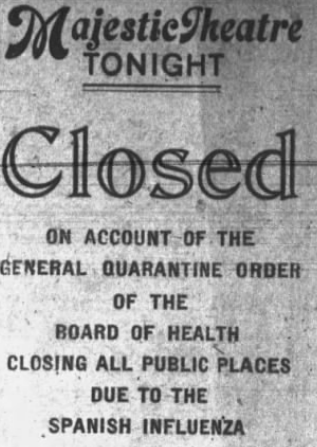
Despite experiencing setbacks, the compliance of businesses, schools, politicians, and the public enabled Indiana to avoid a much worse outcome. After the isolation of quarantine and the solitude of winter, on May 7, 1919, 20,000 men and women congregated in Indianapolis’s welcome parade. For thirty-three blocks, Hoosiers honored victorious troops returning from World War I combat—no masks or social distancing needed.

Notes:
[1] “No Public Assemblages,” Princeton Daily Clarion, October 7, 1918, 1, accessed Newspapers.com.
[2] Ibid.
[3] “Closing the Town,” Terre Haute Tribune, October 9, 1918, 4, accessed Hoosier State Chronicles.
[4] “Wanted-Situation,” Terre Haute Tribune, October 8, 1918, 15, accessed Hoosier State Chronicles.
[5] “State Board Orders Homes Placarded,” South Bend News-Times, 1, accessed Hoosier State Chronicles.
[6] “From Lonesome Boys,” Hammond Times, October 9, 1918, 13, accessed Hoosier State Chronicles.
[7] Ibid.
[8] “Influenza is Not Epideic [sic] in This County,” The Republic [Columbus, IN], October 23, 1918, 1, accessed Newspapers.com.
[9] “Influenza and Fear,” South Bend News-Times, October 11, 1918, 8, accessed Hoosier State Chronicles.
[10] “Teachers to Get Contract Wages,” The Tribune [Seymour, IN], October 10, 1918, 1, accessed Newspapers.com.
[11] “Near Beer Places Are Closed,” The Tribune [Seymour, IN], October 11, 1918, 1, accessed Newspapers.com.
[12] “No Church Services will be Held Here Tomorrow,” The Tribune [Seymour, IN], October 12, 1918, 4, accessed Newspapers.com.
[13] “Quarantine Brings Memories of Summer,” Palladium-Item [Richmond, IN], October 19, 1918, 9, accessed Newspapers.com.
[14] “To Begin Gym Work When Ban is Off,” Evansville Press, October 16, 1918, 10, accessed Newspapers.com.
[15] “Students at Earlham Remain within Campus,” Indianapolis News, November 2, 1918, 7, accessed Hoosier State Chronicles.
[16] “Campaign is Very Quiet this Fall,” The Tribune [Seymour, IN], October 19, 1918, 1, accessed Newspapers.com.
[17] “No Danger of Influenza,” The Evening Star [Franklin, IN], October 11, 1918, 1, accessed Newspapers.com.
[18] Terre Haute Tribune, November 3, 1918, 14, accessed Hoosier State Chronicles.
[19] “‘Flu’ Cases are Growing Less,” South Bend News-Times, November 12, 1918, 8, accessed Hoosier State Chronicles.
